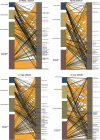Ecological filters shape arbuscular mycorrhizal fungal communities in the rhizosphere of secondary vegetation species in a temperate forest
- PMID: 39869612
- PMCID: PMC11771869
- DOI: 10.1371/journal.pone.0313948
Ecological filters shape arbuscular mycorrhizal fungal communities in the rhizosphere of secondary vegetation species in a temperate forest
Abstract
The community assembly of arbuscular mycorrhizal fungi (AMF) in the rhizosphere results from the recruitment and selection of different AMF species with different functional traits. The aim of this study was to analyze the relationship between biotic and abiotic factors and the AMF community assembly in the rhizosphere of four secondary vegetation (SV) plant species in a temperate forest. We selected four sites at two altitudes, and we marked five individuals per plant species at each site. Soil rhizosphere samples were collected from each SV plant species, during the rainy and dry seasons. Soil samples from the rhizosphere of each plant species were analyzed for AMF spores, organic matter (OM), pH, soil moisture, and available phosphorus, and nitrogen. Three ecological filters influenced the AMF community assembly: host plant identity, abiotic factors, and AMF species co-occurrence. This assembly consisted of 61 AMF species, with different β-diversity values among plant species across seasons and altitudes. Canonical correspondence analysis revealed that AMF community composition is linked to OM and available P and N, with only a few AMF species co-occurring, while most do not. Our study highlights how ecological filters shape AMF structure, which is essential for understanding how soil and environmental factors affect AMF in SV plant species across seasons and altitudes.
Copyright: © 2025 Vázquez-Santos et al. This is an open access article distributed under the terms of the Creative Commons Attribution License, which permits unrestricted use, distribution, and reproduction in any medium, provided the original author and source are credited.
Conflict of interest statement
The authors have declared that no competing interests exist.
Figures






Similar articles
-
Diversity of Arbuscular Mycorrhizal Fungi in a Brazilian Atlantic Forest Toposequence.Microb Ecol. 2016 Jan;71(1):164-77. doi: 10.1007/s00248-015-0661-0. Epub 2015 Aug 25. Microb Ecol. 2016. PMID: 26304552
-
Differential Responses of Arbuscular Mycorrhizal Fungal Communities to Long-Term Fertilization in the Wheat Rhizosphere and Root Endosphere.Appl Environ Microbiol. 2021 Aug 11;87(17):e0034921. doi: 10.1128/AEM.00349-21. Epub 2021 Aug 11. Appl Environ Microbiol. 2021. PMID: 34160265 Free PMC article.
-
High-throughput sequencing analysis of the rhizosphere arbuscular mycorrhizal fungi (AMF) community composition associated with Ferula sinkiangensis.BMC Microbiol. 2020 Nov 3;20(1):335. doi: 10.1186/s12866-020-02024-x. BMC Microbiol. 2020. PMID: 33143657 Free PMC article.
-
Atmospheric nitrogen deposition impacts on the structure and function of forest mycorrhizal communities: A review.Environ Pollut. 2019 Mar;246:148-162. doi: 10.1016/j.envpol.2018.11.074. Epub 2018 Nov 28. Environ Pollut. 2019. PMID: 30543941 Review.
-
Prospects for arbuscular mycorrhizal fungi (AMF) to assist in phytoremediation of soil hydrocarbon contaminants.Chemosphere. 2016 Nov;162:105-16. doi: 10.1016/j.chemosphere.2016.07.071. Epub 2016 Jul 31. Chemosphere. 2016. PMID: 27487095 Review.
References
MeSH terms
Substances
LinkOut - more resources
Full Text Sources

